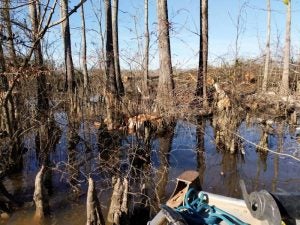Buffer width depends on site, benefits
Published 10:15 am Monday, January 21, 2019
In Virginia, loggers are required to protect water quality, and the VDOF developed Best Management Practices (BMPs) as guidelines for proper timber harvesting for Virginia’s loggers. To monitor VOLUNTARY implementation of these guidelines, the VDOF began conducting Best Management Practice Field Audits in 1993. Conducted four times a year and compiled in one annual report, the field audits provide a useful tool in gauging the status of Virginia’s water quality protection efforts with regard to silvicultural activity.

More logging in a cypress swamp very close to the Nottoway River. The RiverGuard notes that trees standing in water were cut with no buffer at all.
Below is what is RECOMMENDED as a buffer. One day maybe these will be law, I still do not understand why it is not. A voluntary law is not a law and is basically useless.
The following paragraph was taken from the Virginia Department of Forestry website:
Julia C. Klapproth, Faculty Assistant-Natural Resources, Maryland Cooperative Extension; and James E. Johnson, Extension Forestry Specialist, College of Natural Resources, Virginia Tech
How wide does the riparian buffer need to be? Unfortunately, there is no one single “ideal” buffer width. The proper buffer width depends on site characteristics and the benefits expected from the buffer. In the Chesapeake Bay region, a buffer of 35 feet on each side of the stream is generally suggested to benefit the aquatic community, with the buffer expanding to 75 to 100 feet per side to produce water quality and wildlife benefits (Palone and Todd 1997).
Other researchers have suggested different “rules of thumb” for determining the proper buffer width. Verry (1996,) a hydrologist with the U.S. Forest Service in Minnesota, suggests that a proper width for riparian management is “the active 50-year floodplain plus the terrace slopes,” or approximately 10 times the stream “bankfull” width plus 50 feet on either side (Verry 1996.)
In the Pacific Northwest, a team of scientists known as the Federal Ecosystem Management Assessment Team (FEMAT) recommends buffer widths (per side) equal to the height of a “site-potential tree,” or the average maximum possible tree height for that site (the average “site-potential tree” in the eastern U.S. is 110 feet.) (O’Laughlin and Belt 1995.) They suggest that many buffer functions (for example, providing shade, leaf litter, large woody debris and stabilizing streambanks) are met with a buffer width of one site-potential tree height. However, others suggest that wildlife and water quality benefits require a wider buffer.





